Elite freestyle wrestlers’ competitive performance analysis
Фотографии:
ˑ:
Master of Sports of the Russian Federation V.V. Efremov1
PhD, Associate Professor M.G. Kolodeznikova1
1M.K. Ammosov Northeastern Federal University, Yakutsk, Republic of Sakha (Yakutia)
Keywords: competitive performance, technical and tactical training, elite wrestlers.
Background. Modern competitive process implies the athletic skills in different sports being demonstrated and rated as required by the relevant rules of competitions, standard actions and techniques of competitions and scoring rules and procedures. Clear and full knowledge of the content and results of a competitive process in every sport discipline is indispensable as it helps: design and manage the training process with its models, tools, methods, training loads and off-training factors; make an objective assessment of competitive performance in every event and component, with fast and fair finding of the reasons for success or defeat; make timely corrections to the training system and process; step up efficiency of the tactical training component and prudently select the most successful tactics for specific competitive bouts with due consideration for individual goals and skills of would-be opponents; and model upcoming competitive situations in the training process [2, p.79]. Therefore, the national sport communities have been giving a growing priority to the studies of the competitive process regularities for the last few years.
It is the individual technical and tactical actions (TTA) that are commonly known to determine success of every athlete in every competitive bout [1, p. 75]. Modern theoretical and practical provisions for the elite wrestlers’ training systems are generally designed to help the athletes effectively select, master and improve the most efficient TTA. It should be noted that content and design of the most efficient TTA are being fast revised in modern sport practices; and this is the reason why the wrestlers and coaches need to be duly and timely informed on the most promising developments in modern wrestling sport, with a special emphasis on the actual competitive performance records of the leading wrestlers [3, p. 8].
Objective of the study was to classify the technical and tactical actions applied by the leading freestyle wrestlers based on video captures of their competitive performance.
Methods and structure of the study. The study data were obtained by an expert analysis of the elite wrestlers’ competitive performance in 2015 World Championship (WC) in Las Vegas, 2015 European Games (EG) in Baku and 2015 Golden Grand Prix (GGP) in Baku. Competing in the 2015 (September 7-12) World Championship in Las Vegas were 23 elite wrestlers (61kg weight category) representing every leading wrestling nation of the world, with 6 their bouts being subject to our study. Competing in the 2015 (June 13-18) European Games in Baku were 15 elite wrestlers of 61kg weight category, with 5 bouts being subject to our study. And competing in the 2015 (November 27-29) Golden Grand Prix (GGP) in Baku were 12 elite wrestlers of 61kg weight category, with 4 final bouts being subject to our study.
Study results and discussion. Our analysis of the wrestlers’ competitive performance in the 2015 World Championship made it possible to identify the following top-seven popular techniques: turnovers: 6 times (20%); reverse body holds: 1 (3.3%); arm pulls and duckunders: 1 (3.3%); arm-roll throws: 1 (3.3%); push-outs from the carpet: 5 (16.7%); ankle picks: 13 (43.4%); and stand-up counterattacks: 3 (10%). In the 2015 European Games, the following top-six popular techniques were used: turnovers: 2 (5.9%); arm pulls: 1 (3%); throws: 1 (3%); push-outs from the carpet: 4 (11.7%); ankle picks: 21 (61.7%); and counterattacks: 5 (14.7%). In the 2015 Golden Grand Prix in Baku, the following techniques were the most popular: turnovers: 1 (10%), arm pulls: 1 (10%); throws: 1 (10%); push-outs from the carpet: 2 (20%); ankle picks: 3 (30%); and counterattacks: 2 (20%). The study data showed the competitive performance rates of wrestlers A and B being notably different: see Figures hereunder.
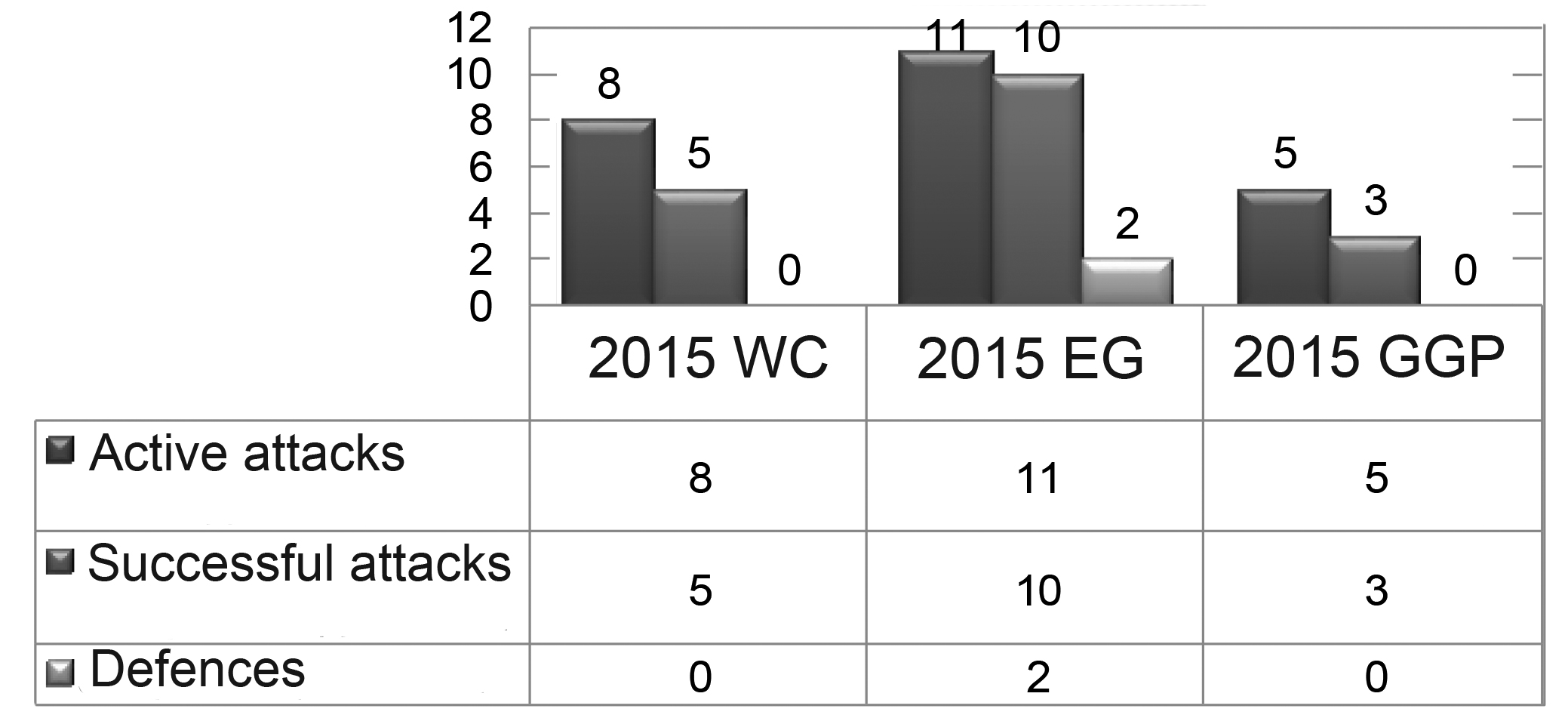
Figure 1. Range of attacks and defences demonstrated by wrestler A.
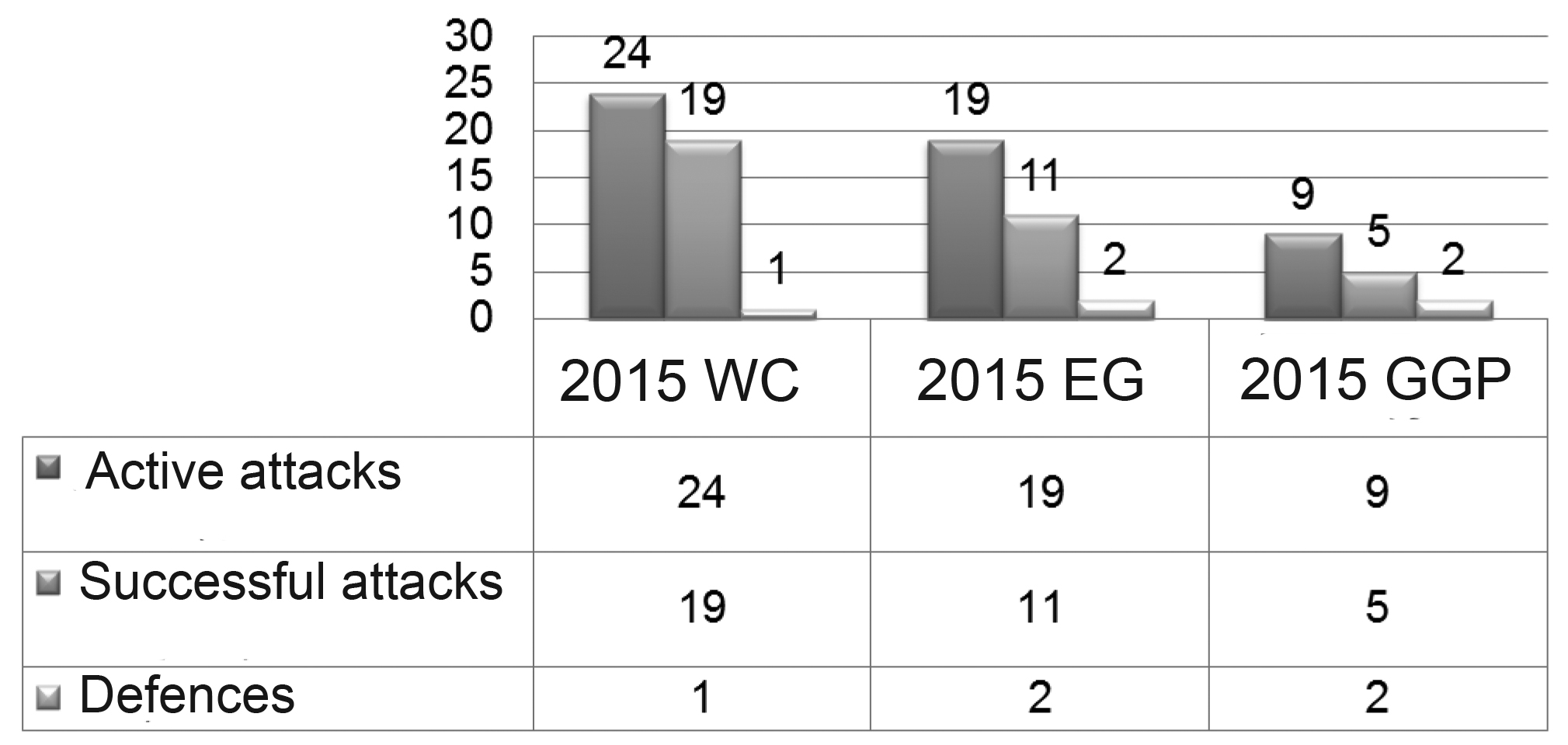
Figure 2. Range of attacks and defences demonstrated by wrestler B.
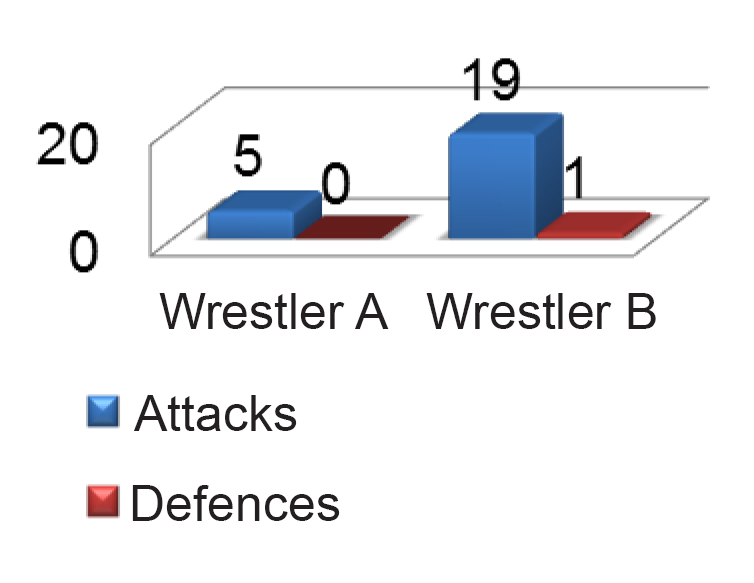
Figure 3. 2015 WC
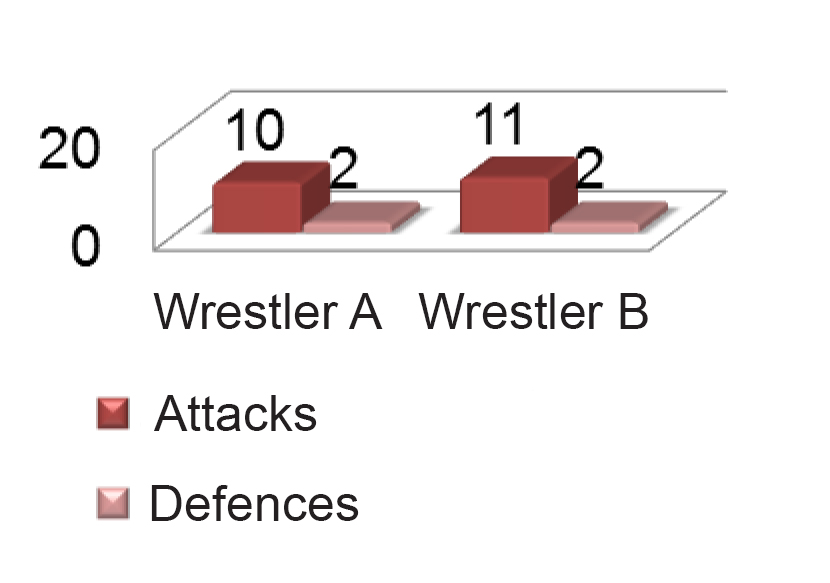
Figure 4. 2015 EG
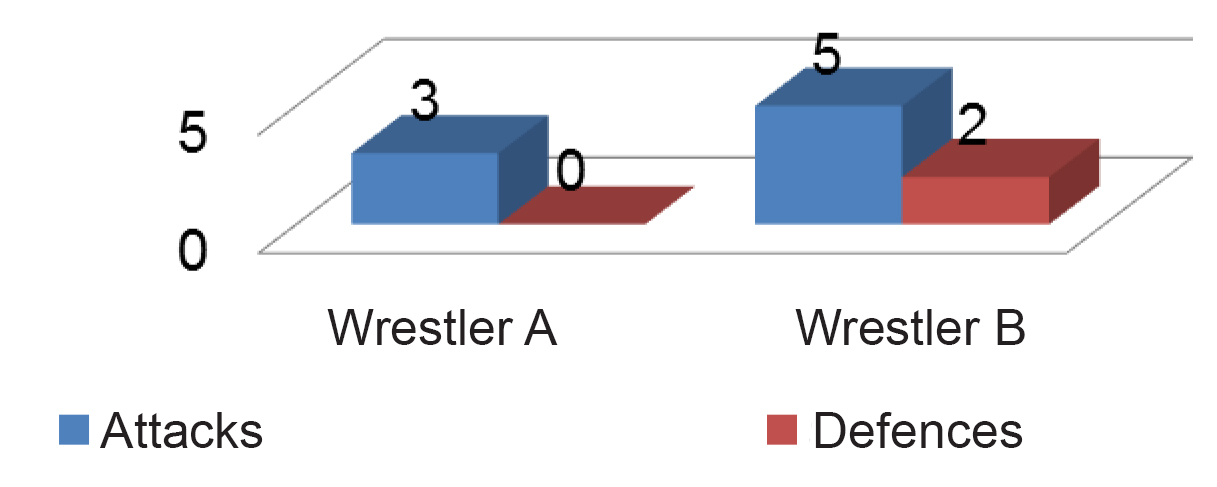
Figure 5. 2015 GGP
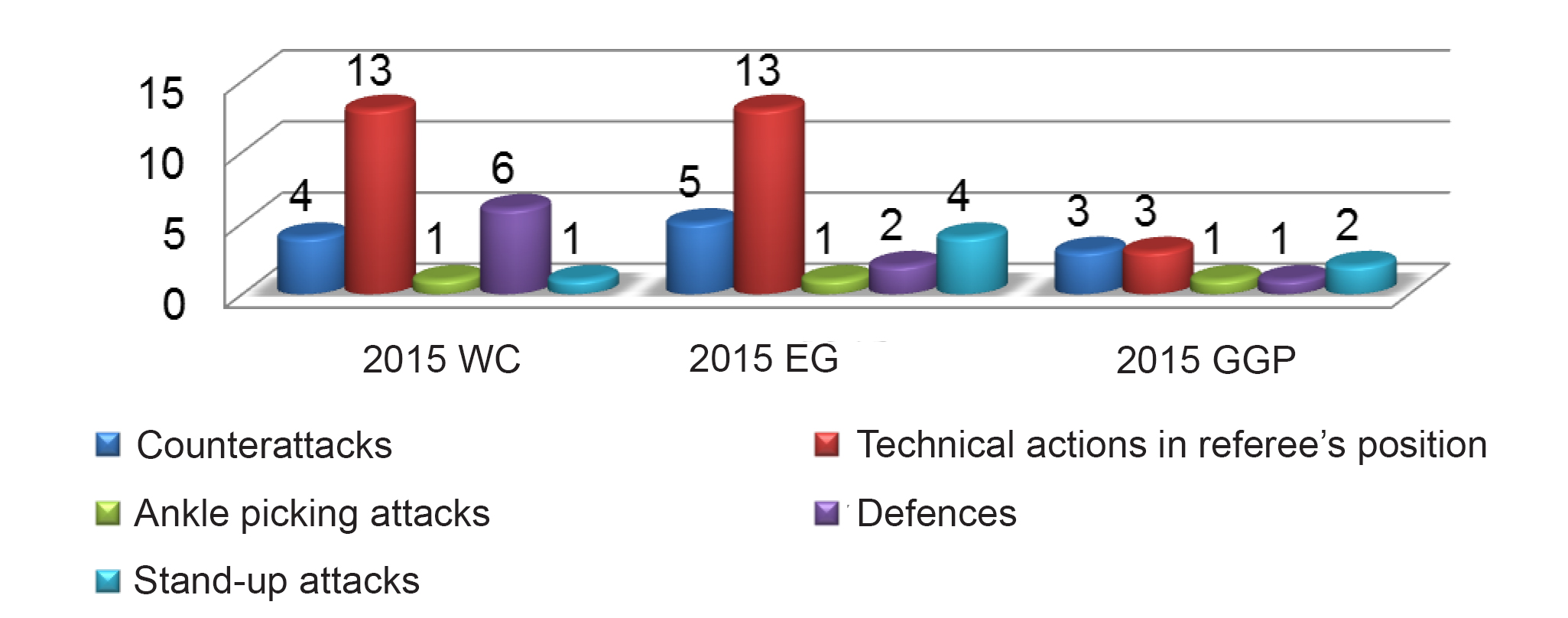
Figure 6. Range of attacks and defences demonstrated by elite wrestlers
The elite freestyle wrestlers’ competitive performance analysis showed that in the 2015 WC it was dominated by the stand-up actions versus referee’s position actions as 23 (76.7%) versus 7 (23.3%) respectively; the same trend was found in their competitive performance in the 2015 EG, with the stand-up actions ratio to the referee’s position actions making up 32 (94.1%) versus 2 (5.9%), respectively; and the 2015 GGP was no exclusion from the trend with the ratio estimated at 9 (90%) versus 1 (10%).
The competitive performance analysis, as provided in Table 1 hereunder, shows that elite wrestlers are generally better, among other things, in the competitive techniques and tactics being applied in a more stable and successful manner; and in the ability to effectively impose own fighting style on the opponent.
Table 1. Competitive performance rates of wrestlers A and B in the 2015 World Championship
|
Wrestlers |
Competitive performance rates of wrestlers A and B |
||||||||||||||||||||
|
Attacks, total |
Counterattacks, total |
Ankle picks |
Stand-up attacks |
Ref’s position actions |
Defences |
Warnings |
|||||||||||||||
|
Total |
Scored |
% |
Total |
Scored |
% |
Total |
Scored |
% |
Total |
Scored |
% |
Total |
Scored |
% |
Total |
Scored |
% |
Total |
Scored |
% |
|
|
Wrestler A 1/16 final Score 10-0 |
4 |
4 |
100 |
0 |
0 |
0 |
1 |
1 |
100 |
1 |
1 |
100 |
2 |
2 |
100 |
0 |
0 |
0 |
0 |
0 |
0 |
|
Wrestler A 1/8 final Score 3-4 |
4 |
1 |
25 |
0 |
0 |
0 |
4 |
1 |
25 |
0 |
0 |
0 |
0 |
0 |
0 |
1 |
0 |
0 |
2 |
2 |
100 |
|
Wrestler B 1/8 final Score 11-2 |
7 |
6 |
85,7 |
1 |
1 |
100 |
6 |
5 |
83,3 |
0 |
0 |
0 |
0 |
0 |
0 |
2 |
0 |
0 |
1 |
1 |
100 |
|
Wrestler B ¼ final Score 6-2 |
6 |
4 |
66,6 |
3 |
2 |
66,7 |
3 |
2 |
66,7 |
0 |
0 |
0 |
0 |
0 |
0 |
3 |
1 |
33,3 |
2 |
2 |
100 |
|
Wrestler B ½ final Score 6-2 |
5 |
3 |
60 |
0 |
0 |
0 |
4 |
2 |
50 |
0 |
0 |
0 |
1 |
1 |
100 |
0 |
0 |
0 |
1 |
1 |
100 |
|
Wrestler B Final Score 10-0 |
6 |
6 |
100 |
1 |
1 |
100 |
2 |
2 |
100 |
0 |
0 |
0 |
3 |
3 |
100 |
0 |
0 |
0 |
0 |
0 |
0 |
Conclusion. Having analysed the wrestlers’ competitive performance in the 2015 World Championship in Las Vegas, 2015 European Games in Baku and 2015 Golden Grand Prix in Baku, we found the competitive techniques being dominated by high-pace attacks taken without prior preparations, particularly when the athlete is confident of success. The highly-skilled wrestlers demonstrated high success rates of the techniques for the whole bout (in both periods). Furthermore, the tactical skills were found to heavily contribute to the quality of technical skills since it is always important for a wrestler to find, create favourable moments in the dynamic fight situation for attacks and counterattacks.
The study data and analysis of the elite wrestlers’ competitive performance in the 2015 World Championship in Las Vegas, 2015 European Games in Baku and 2015 Golden Grand Prix in Baku made it possible to range the technical and tactical actions favoured by modern elite freestyle wrestlers; and find the key competitive performance rates including every action frequency, success and dependability rates in typical competitive situations. It should be noted that the elite wrestlers tend to be highly rational in their competitive techniques that means that most of the leading wrestlers tend to avoid the moves potentially fraught with a risk of point deduction including high crotches over the head (“mills”), ankle picks, trips, hip-rolls and drop-backs. In stand-up positions, the wrestlers were found to prefer leg takedowns; and in referee’s position – turnovers and stretchers.
References:
- Akopyan A.O., Novikov A.A. Analiz kharakteristik sorevnovatelnoy deyatelnosti kak faktor postroeniya trenirovochnogo protsessa v edinoborstvakh. Uchebnoe posobie [Analysis of characteristics of competitive activity as a factor in martial arts training process design. Study guide]. Moscow: VNIIFK publ., 1985, 18 p.
- Bestinov R.V., Kolodeznikov K.S. Sravnitelny analiz sorevnovatelnoy deyatelnosti bokserov vysokoy kvalifikatsii ligi WSB [Comparative analysis of elite WSB boxers' competitive performance data]. Teoriya i praktika fiz. kultury, 2016, no.11, pp. 79-80.
- Mindiashvili D.G., Podlivaev B.A. Planirovanie podgotovki kvalifitsirovannykh bortsov: metod.rekomendatsii [Skilled wrestlers’ training design: methodical recommendations]. Moscow, 2000, 32 p.
Corresponding author: efremov2016@mail.ru
Abstract
The article analyses competitive performance of elite freestyle wrestlers in 2015 World Championship (WC) in Las Vegas, 2015 European Games (EG) in Baku and 2015 Golden Grand Prix in Baku. The analysis of the freestyle wrestlers’ competitive performance records made it possible to range their key competitive technical and tactical actions and profile the individual competitive performance of each wrestler with every action frequency, success and dependability rates in typical competitive situations. It should be noted that the elite wrestlers tend to be highly rational in their competitive techniques that means that most of them tend to avoid the moves potentially fraught with a risk of point deduction including high crotches over the head (“mills”), ankle picks, trips, hip-rolls and drop-backs. In stand-up positions, the wrestlers were found to prefer leg takedowns; and in referee’s position – turnovers and stretchers.




